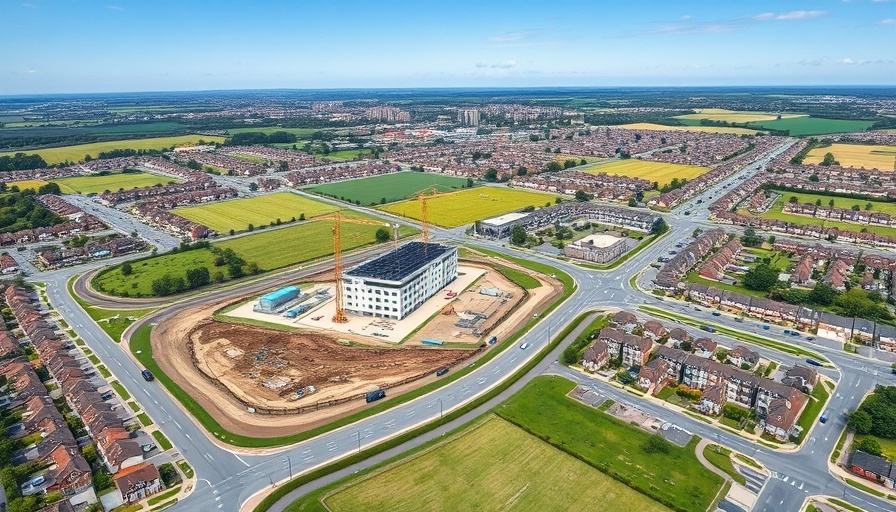
Understanding the Recent Dip in Construction Planning
The recent report from Dodge Construction Network indicates a subtle yet notable shift in nonresidential construction planning, as the Dodge Momentum Index (DMI) recorded a 0.7% uptick in February, contrasting with slower growth in institutional and commercial sectors. While an increase is always welcome, the context reveals complexities that industry stakeholders must navigate. A deeper look at these changes can illuminate potential strategies for contractors, homeowners, and investors.
Key Drivers of Change: The Spotlight on Data Centers
Data centers have once again emerged as crucial players in the construction landscape. According to Dodge’s data, these facilities drove a 3.3% increase in commercial planning despite an overall slowdown in other sectors, particularly institutional planning, which dropped by 4.6%. The booming demand for data centers greatly compensates for the wavering enthusiasm in other project types. If data center initiatives were excluded from the equation, the DMI would have shown a decline of 2%—a sobering thought for stakeholders relying on robust growth in diverse areas of construction.
Institutional Sectors Lag: Challenges Ahead
The downturn in institutional planning is particularly concerning as it encompasses essential infrastructures like hospitals and educational facilities. With a reported 4.6% contraction, this segment is critical to monitor, especially in a climate where fiscal uncertainties—around materials and government spending—may increasingly affect decision-making. Sarah Martin, Associate Director of Forecasting at Dodge, says, "Increased uncertainty around material prices and fiscal policies may begin to weigh on planning decisions." This caution signals potential hurdles for contractors poised for public sector projects.
The Year-on-Year Context: A Cautious Optimism
While February indicated a moderation in growth, it’s important to contextualize these metrics within the last year. The DMI reflects a robust increase of 27% compared to February 2024, fueled largely by the 43% surge in commercial planning. For contractors and businesses, this long-term perspective can be crucial, showcasing that, while short-term adjustments are necessary, the overall trend remains optimistic. Those willing to adapt strategies in response to current loss in institutional confidence may observe landscape shifts towards commercial opportunities, especially in tech-centric fields.
Navigating Economic Uncertainties: What It Means for Contractors
For home service contractors and industry stakeholders awaiting the next wave of growth, it’s vital to stay informed about shifting market dynamics. The impact of increasing costs and potential government fiscal adjustments can create more intense competitive environments. Contractors who diversify their projects and adapt to emerging trends—especially the pivot towards technology-based commercial spaces—are less likely to suffer lasting setbacks. ProHomeGuides advocates for leveraging AI technologies to enhance bidding processes and project management, ensuring businesses can navigate through challenges effectively.
Common Misconceptions about Construction Trends
One prevalent misconception is that growth in construction is uniformly steady across all sectors. In reality, fluctuations, like the recent slump in institutional planning, reveal the complexities that can influence the broader market. Recognizing these variances allows contractors and homeowners to make informed decisions regarding investments or project startups—whether leaning into commercial opportunities or preparing for potential implications in public infrastructure projects.
Stepping into the Future: Predictions for Construction Planning
The future holds a plethora of uncertainties, particularly around material costs and financing. Nevertheless, predictions suggest that as economic pressures ease and confidence in market recovery solidifies, a resurgence in planning—both residential and commercial—could occur. This creates an opportunity for proactive contractors who can implement best practices and leverage emerging technologies to stay ahead. Economic analysts predict that by mid-2025, a resurgence in confidence could lead to an uptick in institutional projects, if financial trends shift favorably.
Take Action: Stay Informed and Adapt
For contractors, homeowners, and other industry stakeholders, the insights derived from the latest DMI are more than just numerical. They represent opportunities to adapt, reconsider project timelines, and strategically allocate resources. Staying ahead entails remaining updated on industry trends, embracing technology, and preparing for shifts in policy and material costs. Whether you're a homeowner planning a renovation or a contractor seeking to adapt to market trends, there’s a wealth of insight here. Leverage these perspectives to make informed decisions that ensure the longevity and success of your projects.
 Add Row
Add Row  Add
Add 




Write A Comment